
I had an academic project where I looked at images of Jesus, specifically five evangelical Christs, and discussed how they reflect evangelical beliefs. This essay is an adaptation of that research.
Evangelicalism is not a monolithic movement, and one finds a great deal of theological diversity within the movement. It is my belief that art is not only reflective of the philosophy (in this case, theology) of the artist, but it is also reflective of the theology of those persons who are patrons of the work. It is not my purpose to argue the orthodoxy or heterodoxy of these theologies but to reflect upon how these artworks are reflective of evangelical perspectives on Christ, regardless of their theological validity.
This piece is split into five sections, reflecting on one of the five evangelical Christs in my project. These posts are less my actual research on these pieces and more simply me “talking” about these paintings and how they are reflective of the evangelical perspective. The five Jesuses are:
- Head of Christ by Warner Sallman
- Christ on the Cross by Peter Paul Rubens
- Sacrifice by Edward Knippers
- Walk of Faith and The Cross by Thomas Kinkade
- Oblation by Emmanuel Garibay
With the exception of the Rubens piece, these are all modern or contemporary works. I’ll below the Rubens painting fits into the project. For Kinkade, I chose two works that provide for consideration a fuller expression of the Kinkadian Christ.
Warner Sallman: Popular Christ
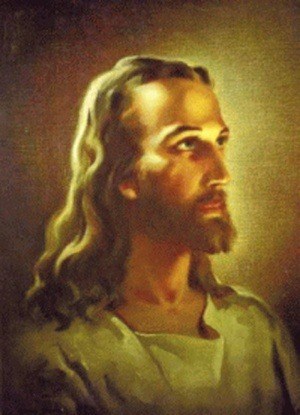
Warner Sallman’s Head of Christ is an icon of American religious art. Painted in 1941 the image was continuously reproduced throughout World War II and the YMCA and Salvation Army, as a part of the USO, handed out the image to soldiers during the war. The image had continued success after the war with some groups intentionally seeking to place reproductions of Head of Christ in both public and private locations throughout the Midwest. This image has become the most reproduced image of Christ with over 500 million reproductions.
This leads to two key questions. First, why did Sallman choose to depict Jesus in the way he did? Second, what accounts for the tremendous popularity of the image? These are actually difficult and complicated questions; but, I will briefly outline some of the major contributing factors.
One of the main reasons for Sallman depicting Jesus in this way is primarily religious, not artistic. Early 20th-century American evangelicalism experienced many trials. From the late 19th through early 20th century was the Modernist-Fundamentalist (Liberal-Evangelical to use current terminology) controversy where the influences of Darwinian evolution and Higher Criticism wreaked havoc on the religious life of conservatives. This controversy created a climate where much of the religious influence of modernism came under scrutiny. This extended to the more effeminate depictions of Jesus common to the Victorian era. Sallman claimed to have been encouraged by a Moody Bible Institute teacher around the time of World War I to stay an artist. The teacher encouraged Sallman to one day paint an image of Christ saying. “I hope someday you give us your conception of Christ. Most of the pictures I have seen are too effeminate. I hope you’ll picture a virile, manly Christ.” This sort of thinking has lasted many years. Famed evangelical art historian Hans Rookmaaker wrote in his 1970 book Modern Art and the Death of Culture:
“Could it be that the false ideas that many people, non Christians as well as Christians have of Christ as a sentimental, rather effeminate man, soft and ‘loving’ never really of this world, are the result of the preaching inherent in the pictures given to children or hanging on the wall? Their theology, their message, is not that of the Bible but of nineteenth century liberalism.”
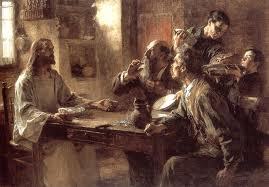
The theologically conservative Sallman sought to create a “virile, manly Christ” as his Bible teacher had suggested. But, he did not do so without art historical awareness or the savvy he had learned during his years as a commercial artist. Most art historians agree that Sallman used the Leon Lhermitte painting The Friend of the Humble as the source for his Head of Christ. Sallman acknowledged that he was familiar with the piece and that he had given a print of the Lhermitte painting to his mother as a gift. However, the choice to close in on the head of Christ in a three-quarter view seems thoughtful not accidental. Further, Sallman’s Christ is not painted in a room but with an ethereal space around him which is reminiscent of a photography studio setting. As a result, Sallman’s Jesus is a contemporary figure. His facial structure and skin tone hint at a northern European heritage, his features are masculine yet gentle, and his pose is much like the celebrity face shots common within popular culture at that time.

The great popularity of Sallman’s Head of Christ, though, may lie in the fact that the painting is sufficiently open to interpretation. The depiction of Christ is both strong and gentle allowing the viewer to read into the image the facets of Jesus the viewer finds most compelling. The format, which hinted at celebrity, made Sallman’s painting the original Jesus Christ Super Star. But, clearly a humble superstar able to serve as a devotional icon in the homes of protestants across America. Maybe most importantly, Sallman’s Christ seems very personal. His masculinity pushes toward emotional strength but there is a tenderness in his look that invites the viewer to identify with him. Yet, as important as any of these may be, the strong ties to commercialization made Sallman’s Head of Christ readily reproduced and available to people at a very reasonable price. The images were often found in inexpensive frames with devotional texts. The image is highly accessible and was often found on cards and in Church bulletins.
Evangelicals today have grown up in a culture where the Sallman image is the most recognized image of Christ. This ubiquitous image has shaped the perception of Christ in untold ways. For many evangelicals, this image has helped to associate an Anglo Christ with the largely white evangelical movement. This image also resonates well with the evangelical concept of a personal savior. Sallman’s Christ does not evoke the feeling of Christ as king but rather Christ as a friend. The image corresponds well with the complementarian view of gender roles held by many evangelicals. Christ is a masculine and kind individual to whom we are to submit.
Ironically while the Head of Christ was an imminently contemporary piece in 1941, it also generated a sort of nostalgia hearkening back to a simpler, more religious, and more pious time. This sense of nostalgia is even stronger today. The evangelical culture was born of a separatist spirit. In some ways despite the political activism of evangelicalism over the last 30 years, that separatist spirit is more potent now. Many evangelicals long for a time when the United States was a Christian nation. They idealize the “golden era” of America when the streets were safe and the Ten Commandments were on courthouse walls. They reminisce about the days when personal devotion and public piety lived in harmony. A simpler time when their parents or grandparents hung their first Warner Sallman print on the wall. There is little doubt that this cultural memory is highly idealized, even simplistic, but it is powerful. The same may be said of the Head of Christ. Jesus was not a blue-eyed northern European. His life was filled with trial and pain. But, in Sallman’s painting, we see only Christ’s peace.
Peter Paul Rubens: Victorious Christ
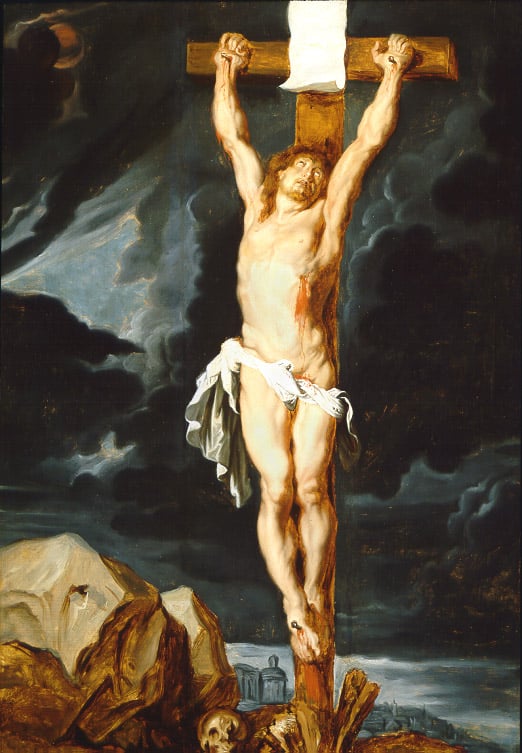
This section is a bit different than all the others in that Peter Paul Rubens is not a modern or contemporary artist. The question then becomes, how does a four-hundred-year-old painting by a Catholic artist fit into American evangelicalism?
The answer is actually found in the collection in which the painting currently resides. In the middle part of the 20th century, Bob Jones University, at the impetus of its President Bob Jones Jr., was one of the world’s greatest collectors of religious art. The bulk of the Bob Jones University Collection came from its inception in 1951 through 1968. In 1960, right in the middle of this growth period, Bob Jones Jr. acquired Peter Paul Ruben’s Christ on the Cross which is believed to be the modello that Rubens kept in his studio from which apprentices would work.
In Rubens’ painting, Christ is powerfully muscular and despite the blood spilling from his wounds and the tortuous piercing of the nails, Christ remains in control. Consistent with Catholic pictorial tradition Christ is not overwhelmed by his pain and demonstrates a dignity transcendent of his agony.
For over 50 years, this image was on display on the Bob Jones University Campus. (The collection is currently in transition to an off-campus location.) To the delight of some and the consternation of others, BJU has been one of the most influential Christian Universities over the last 80 years and images like this do help develop a cultural ethos.
Christ’s victorious position here is powerful, especially considering the evangelical theology of the “finished work of the Cross” where Christ once and forever triumphed over sin. Art Historian David Steele wrote:
[Christ] suffers heroically, his muscles tense, his fingers clenched, and his arms raised above his head, thrusting his torso upwards. The image emphasizes the physical sacrifice which Christ suffered on the behalf of all mankind, yet his upward straining…suggests his ultimate triumph. The effect is powerfully dramatic and profoundly moving.
The tension between Christ sacrificing and Christ simultaneously achieving victory is evocative of the evangelical spirit. Evangelicals believe that humanity exists in a fallen world filled with pain and sin while believers have a settled fate. Despite their pain and challenges, believers are “not yet” and “already” victorious over sin because of their faith in Christ. This Rubens is consonant with the evangelical optimism that despite the trials of this world we are just passing through and ultimately there is victory in Jesus.
Edward Knippers: Sacrificing Christ
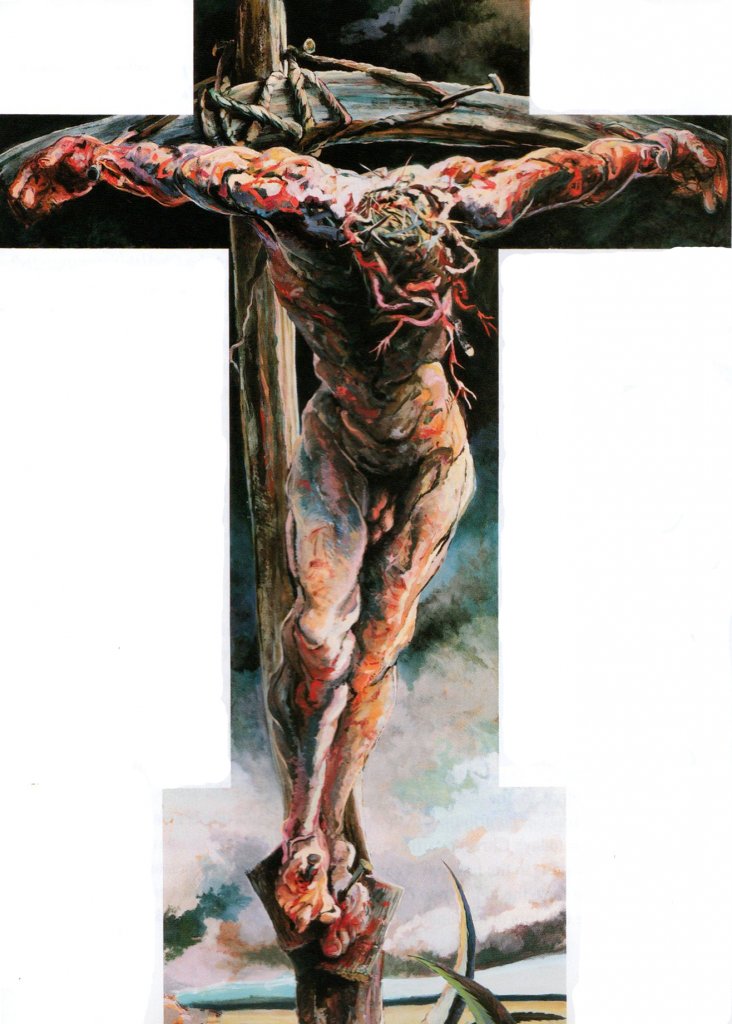
Edward Kinppers is the first contemporary artist I am looking at in this series. For several decades, Knippers has been among the most prominent evangelical artists in the United States. But, during his career, he has also been a controversial figure. In 1983, Knippers began working exclusively with images of Biblical scenes. These scenes have been painted with all participating figures in the nude. The nudity in Knippers’s work has been cause for attacks against his work on several occasions. When Knippers exhibited his work at Huntington College the College administration in the face of protests reluctantly closed the exhibition. When his work was exhibited at Covenant College it was actually slashed by a vandal who claimed that Knipper’s work “made the Old and New Testaments into a nudist colony.” Within the secular art world, his work has also been castigated for being too Biblical.
It is important to note that Knippers’ work, unlike much contemporary art, is not seeking a shock value or trying to be controversial for the sake of controversy. Knippers sees the nudity as an integral part of his artistic and spiritual statement. At the heart of Edward Knippers’ theology and art is the Incarnation. He views the Incarnation as proof that the body is the meeting of heaven and earth. The body of Christ, in all its brokenness, is essential because, without it, Knippers contends Christ’s sacrifice would not be complete. Without the broken body of Jesus, there can be no redemptive resurrection.
Further, Knippers paints his Biblical figures in the nude because he is striving to avoid cultural trappings such as clothes that tie the images to a particular time and place. He is reaching for a spiritual timelessness. Theologian David Buschart argues that “By omitting dress, Knippers deftly brokers the challenge of both the universality and the particularity, for the absence of dress in his human figures removes an excuse for someone to hold the images at a distance, and yet these are particular people.” For Knippers, the human body is the common element that binds us together throughout time.
Knippers’s work has been generally accepted within the evangelical intelligentsia. Knippers’s work powerfully speaks to doctrines that are the very core of Christianity. However, evangelicalism has strong pietistic roots, and the nudity, physicality, and violence in his work push uncomfortably against those cultural evangelical mores. Knippers argues that evangelicals fail to have a proper understanding of the body in two ways:
- They have an extreme emphasis on sexuality and the worship of the body as demonstrated in “contemporary sexual idolatry, including pornography.” For many evangelicals, nudity equates with pornography but Knippers points out that “Nudity is not necessarily dirty anymore than clothed is necessarily clean.”
- Many evangelicals fail in their understanding of the body through a sort of Gnosticism that rejects the importance of physical creation, calling evil what God called good. Knippers ties this contemporary Gnosticism with the contemporary escape from the physical through the computer and the internet claiming that we do not want to deal with the “unpredictability and uncomfortability” of the body. For many conservative evangelicals, there exists a profound discomfort with the body. The body is to be tamed as its fleshly appetites war with the spirit.
The Sacrifice painted by Knippers in 1986 was at one point displayed in his church on Good Friday. Some members of the congregation found the work incredibly moving but others were so disturbed by the work that they refused to even enter the sanctuary. One woman wrote the pastor to complain about the work but in the very same letter conceded that the painting forced her to reexamine her image of Christ as an infant. It forced her to allow Jesus to grow up. Knippers also tells a powerful and personal story about this painting:
The work was also influential for my godchildren’s father in explaining the meaning of Easter to them. He was trying to use Sunday School literature, most of which is sentimental almost to [the] point of heresy, but the children just could not understand. He then remembered that he has a catalogue of my work, with this crucifixion. When the children saw this image, one of them blurted out. “Oh, He really died.”
Knippers’s work finds its place in the tension between the support of evangelical theology and the discomfort of evangelical culture. Those who support his work often point to the value of incarnational theology, the truth of the violence of his work, and the necessity of understanding the joint universality and particularity of the Christian message. On the other side, those who find problems with Knippers’s work tend to find the nudity problematic and the violence distasteful.
As I was writing this essay, my 8-year-old daughter came up to my computer and saw The Sacrifice. I think our conversation was telling.
“Ewww… Who is that?”
“Jesus” I responded
“Gross!” she said with her face all gnarled up.
“It is supposed to be gross He is on the cross dying.”
Thomas Kinkade: Christ for a world without sin
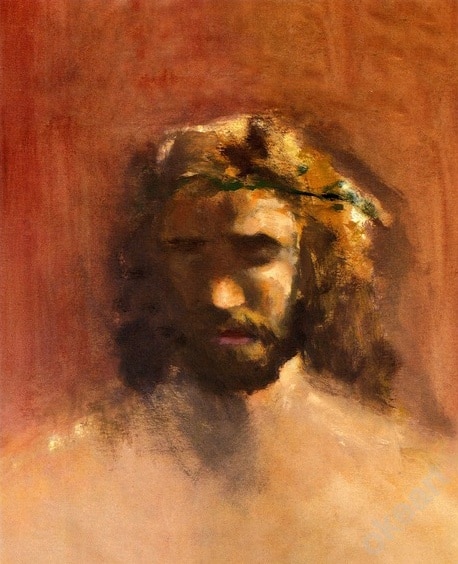
Thomas Kinkade (1958-2012) is simultaneously the most praised and most castigated Christian artist of our time. During his life, he was, monetarily speaking, among the most successful living artists of all time. Kinkade claimed to be the most collected living artist. However, despite his widespread popular success he was never fully accepted by the art world, neither secular nor religious. His controversy only grew after his death when the demons of his personal life became public.
For many evangelicals, Kinkade’s work has a powerful resonance. Embedded deep in his work is a nostalgia similar to what was discussed with Warner Sallman’s Head of Christ. Kinkade is best known for his idealized cabins with a warm light radiating from within. But, he is also known for quaint Main Street scenes, serine lighthouses, and even street scenes from major cities painted in a way that evokes a bygone era. His most known religious works are churches. His churches are typically country churches which, like his cabins, are set in idealized bucolic scenery with warm light shining from within.
Given Kinkade’s public Christianity and the fact that every painting he produced was signed with not just his signature but the Ichthys (fish symbol) and the Biblical citation “John 3:16,” it is easy to view his churches as religious statements. They likely were. In fact, it is probably best to interpret all of his art as a religious statement. However, it is interesting that he produced very few Christocentric images. The first Christocentric print released by Kinkade was The Prince of Peace released in March 1999. According to Kinkade, this image is based on a vision he had in 1980 while in art school and shortly after coming to faith. The piece evokes a very personal feel through the loose handling of paint, the intimate pose of Jesus, and the way the style and subject of the painting contrast with Kinkade’s oeuvre. Kinkade’s career was characterized by a strong commercial drive including massively reproduced prints, commemorative tchotchkes, housing developments, and Disney-themed paintings. But, this piece contrasts with all that. It does not fit well with his signature style and is more about the spiritual peace evoked both in Jesus’ countenance and in the title of the work. However, this work is an outlier in Kinkade’s career and only shows a portion of Kinkade’s view of Christ.

In December 1999, Kinkade released a Christocentric painting that fits more comfortably within his body of work, Sunrise. I first ran across a print of this painting in the lobby of a large church in Louisiana. The pastel tones of the sunrise are reflective of Kinkade’s broader pallet and the painting’s composition hearkens back to romantic painter Caspar David Friedrich just as other paintings by Kinkade often evoke J.M.W Turner, John Constable, or Albert Bierstadt. However, what ties this painting into Kinkade’s oeuvre as much as anything is the marked sentimentality of the painting. Rather than depicting the pain and suffering that the cross evokes for an artist like Edward Knippers or even the sublimity which Friedrich evoked in his paintings of Christ on the cross on a hill, Kinkade depicts the quintessentially protestant empty cross as a sign of the resurrection. The title is potentially even a play on words referencing both the event of Easter morning and the time of day. But, this interpretation creates a tension with Kinkade’s stated purpose of painting as if there were no fall. Without the mark of original sin, the image of the cross loses its potency. It becomes a symbol for God and Christianity, an image of grace. But, a grace that saves humanity from what? The hill on which Kinkade’s cross rests is not Golgatha (the place of the skull) on which Jesus was crucified just outside Jerusalem but a beautiful coastal hill more like Bierstadt’s vision of the new Eden in California than the solemn hills of Friedrich. In fact, despite the compositional similarity to Friedrich it is probably best to view this painting as a part of Kinkade’s Edenic vision.

A later painting by Kinkade, The Cross released in April 2010, takes the cross on a hill but sets it in a space more reminiscent of Thomas Cole and the Hudson River School. This move more directly merges the Edenic vision of Kinkade with the patriotism often found in his post-9/11 work. The American landscape which functioned both as a point of national pride and spiritual reflection for many 19th-century artists serves a similar function for Kinkade in this work. Like 19th-century landscape painters, Kinkade shows an unspoiled dynamic landscape. But for Kinkade, this landscape is not only pure and unspoiled by Western industrialization it is pure and unspoiled by sin. There has been no fall. Eve and Adam left the fruit of the Tree of the Knowledge of Good and Evil on the branch. This, again, creates an unresolved tension between the cross as a symbol of pain and redemption with a landscape that is pain-free and unmarked by moral brokenness. The definitive article “the” in the title further complicates the issue by implicitly tying this cross with The Cross of Christ rather than just a cross.

Kinkade’s fourth and final Christocentric image was released in April 2011 just a year before his untimely death. This final image shows Peter carrying the “symbolic keys to God’s kingdom” while walking and talking with Jesus. The two figures stroll through a typical Kinkadian landscape replete with colorful trees and flowers, waterfalls, a babbling brook, a bridge, and a footpath. In many ways, this image fits more comfortably in Kinkade’s oeuvre than any of his other pictures discussed here. In some ways, this painting returns to the more personal feel found in The Prince of Peace. Viewers can relate to the relational experience of walking and talking with a friend which evokes a strong nostalgia. Yet despite the sense of familiarity, there is also an estrangement of the viewer from the subject. The idealized image reflects more a dream or longing than any actual event. The life of humanity is filled with pain and suffering while this image is devoid of either.
There is no artist who has been more broadly accepted and acclaimed by evangelical culture than Kinkade. While some sneer at his artistic output there is no denying that it resonates strongly with a large portion of the evangelical church. Daniel Siedell writes convincingly but caustically about Kinkade’s work in his article, “The Dark Light of Thomas Kinkade.” Siedell is dismissive of Kinkade’s artistic merit and castigates the theological influence of Kinkade as “not merely problematic, it is dangerous.” he further writes, “Kinkade’s work is the meticulously painted smile on the Joker’s disfigured face. It refuses to deal with the fallenness, brokenness, sinfulness of the world.” Siedell’s writing on this subject produced significant controversy. Yet, despite how one feels about the theological implications of Kinkade’s work there is some truth when Siedell writes “Kinkade’s images prey on his audience’s preconceptions, expectations, and presumptions, restricting rather than broadening or deepening their experience.” For Siedell, this is clearly a pejorative statement but the same argument can be made in a positive light. One can argue that Kinkade uses our preconceptions, expectations, and hopes to provide a comfortable and comforting experience. While this claim has a different moral tone it is essentially the same claim as Siedell’s.
Kinkade’s work lays hold of the nostalgic longing for a simpler, purer time and provides a visual voice for that longing. That is exactly the feeling many evangelicals long for in their religious experience. One can imagine looking at Walk of Faith while singing quietly “Jesus loves me this I know for the Bible tells me so…” Similarly, Contemporary Christian Music is often maligned for sounding like love songs sung to Jesus. That emotional power and connection are exactly what Kinkade delivers in his art.
Emmanuel Garibay: The Everyman Christ

Emmanuel Garibay is different than the other artists in this series in several ways. First, he is a Filipino artist whose work engages the Western tradition but to an extent functions from outside that tradition. This is most evident in the fact that this “Christ” is an Asian Christ. I first met Garibay when we both participated in the Nagel Institute for the Study of World Christianity‘s inaugural seminar which took art professors from North American institutions and connected us with Asian artists and theorists for a two-week experience in Indonesia. There was a great deal of discussion during the seminar about how the images of Christ used in Asian churches were typically Western. The lack of an Eastern Christian visual culture was troubling to some of our Asian counterparts.
However, this image is not merely a depiction of an Asian Christ. There is an ambiguity about the identity of this powerful figure. The body bears the wounds of Christ which imply the identity of Jesus. But, it is not clear. The beardless face and the lack of a Cross separate the image from typical Western images of Christ. The question of identity is further complicated because Garibay’s only written comment about this painting is, “The Oblation represents a fundamental contrast with life, human life asserting itself against a dark and empty space.” Nothing in this statement identifies the image as Christ and, in fact, seems to indicate that the figure is an ordinary human.
Art historian Rachel Smith sees this image as both an image that is “a silent cry that calls us to our stewardship of this world” and through the identification that the wounds of Christ offer “as the model of how we too should live offering our lives in his service.” Garibay is correct that the tension between humanity and the “dark and empty space” is at the core of the human experience but it is the ambiguity of the figure which engenders the power in this image. The figure is both human and divine. It references the incarnation but lacks specificity allowing the figure to function both as Jesus Christ and “Everyman.” This personal identification with Jesus is very powerful for the evangelical mind. Through His pain and sacrifice, he can identify with our pain and sacrifice; and, through our pain and sacrifice, we can identify with His. Here Christ is not merely the friend with whom we talk in Kinkade’s Walk of Faith he is a figure with which we identify on a visceral corporeal level who like us faced the “dark and empty space.” But unlike us, he was victorious despite his oblation. Because of it, we are free to in turn, as Smith said, “offer our lives in his service.”
This Christ is not a trite sentimental Western Christ but a profoundly human Christ whose identity and struggle we share.
The Evangelical Christ
The diversity of the evangelical movement, both theologically and sociologically, provides for a great deal of variety in personal expression. As Randall Balmer expressed, part of the ‘feel’ of evangelicalism is an “interiority” where individual piety is paramount. The artworks of all five of the artists in this study demonstrate that sort of interiority.
Yet, the Christs that are conveyed, at times, are very different. Sallman and Kinkade both depicted a Christ marked by sentimentality—a Christ who provides comfort and is the answer to all troubles. Kinkade, in the minds of some, even pushes the bounds of orthodoxy by depicting a world devoid of the fall. Rubens’ Christ comes out of a Catholic tradition which has a much more developed theology of visual depictions of Christ, but the victorious nature of his Christ who suffers and still looks heavenward in triumph has a powerful resonance. Knippers, on the other hand, is more incarnational in his imagery. His Christ is brutal, beaten, and broken. The sacrifice and humanity of Christ are central to his conception. Knippers engages both the universality and the specificity of his figures and his Christ. Garibay, by contrast, presents a universal Christ. The specificity of the figure is subjugated to the universal as Garibay depicts Christ as an Asian and even a woman. The Imago Dei in humanity comes through as his “Christs” are simultaneously Christ and not Christ.
The Christs of Garibay and Knippers, who are so terribly engaged in this fallen world and the struggles of corporeal humanity, seem so different from the friendly Christ of Sallman or the Edenic Christ of Kinkade. They are very different. It can be argued that Garibay and Knippers are more artistically and theologically sophisticated than Sallman and Kinkade. But that is too simple. In many ways, Sallman and Kinkade represent a broader expression of evangelicalism. It is, in fact, their rejection, or at least disregard, of a more “sophisticated” aesthetic that generates their appeal. They are more democratic, less elitist, and arguably more accessible. Rubens, while clearly sophisticated and functioning well within the High Art tradition, brings a meaningful balance to the pain of life and the victory of Christ. His historical value positions his work as almost beyond reproach and, as such, is able to be appreciated by almost all of evangelicalism.
It is, at least in part, the syncretic nature of evangelicalism that both challenges and invigorates. For the evangelical, Christ is both a friend and a comforter. He was victorious over sin. He suffered. He triumphed. He resonated with the masses and challenged the elites. He challenged the masses and served the elite. At times, it is hard to discern if the evangelical Christ is multifaceted or contradictory. But all evangelicals agree that He is.
This essay is from our Anastasis Series, where we resurrect articles from the past that are either still relevant today or can be easily updated. This piece was first published in May 2013 as a series of six. The six different pieces have been combined into a single essay, edited, and updated.

Your first image made me think immediately of that saccharin song that many Protestant chlldren learn, “Jesus Love Me, This I Know.”
I think that is certainly true. “Jesus Loves Me” may well apply to the work of Kinkade which I will discuss in a couple of days.